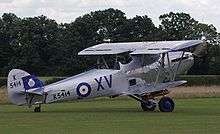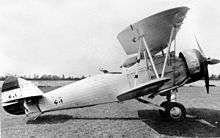Hawker Hind
| Hind | |
|---|---|
.jpg) | |
| Hawker Hind (Afgan), Shuttleworth Collection | |
| Role | Light bomber, Trainer |
| Manufacturer | Hawker Aircraft Limited |
| Designer | Sydney Camm |
| First flight | 12 September 1934 |
| Introduction | 1935 |
| Retired | 1957 (Afghanistan) |
| Primary users | Royal Air Force Iran New Zealand South Africa |
| Produced | 1935-1938 |
| Number built | 528 |
| Variants | Hawker Hart Hawker Hector Hawker P.V.4 |
The British Hawker Hind was a Royal Air Force light bomber of the inter-war years produced by Hawker Aircraft. It was developed from the Hawker Hart day-bomber introduced in 1931.
Design and development
An improved Hawker Hart bomber defined by Specification G.7/34, was purchased by RAF as an interim aircraft while more modern monoplane bombers such as the Fairey Battle were still in development. Structural elements were a mixture of steel and duralumin with the wings being fabric covered while the main differences compared to the earlier Hart was a new powerplant, (the Rolls Royce Kestrel V) and the inclusion of refinements from the earlier derivatives such as the cut-down rear cockpit developed for the Demon. The prototype (Serial number K2915) was constructed very rapidly due to Hawker's development work for other proposals, and made its first flight on 12 September 1934. A variety of changes were subsequently incorporated ("ram's horn" exhaust manifolds, Fairey-Reed metal propeller and engine improvements) with the first production Hind (K4636) flown on 4 September 1935.

Operational history
The Hind went into service in November 1935 and eventually equipped 20 RAF bomber squadrons. A number were also sold to foreign customers including Afghanistan, the Republic of Ireland, Latvia, Persia (Iran), Portugal, South Africa, Switzerland, and Yugoslavia. By 1937, the Hind was being phased out of frontline service, replaced by the Fairey Battle and Bristol Blenheim, with many of the Auxiliary Air Force squadrons changing their role to fighter or maritime patrol units. At the outbreak of the Second World War, 613 Squadron retained the Hind in the Army cooperation role before re-equipping with the Hart derivative, the Hawker Hector, in November 1939.[1] The Hind found a new career in 1938 as a training aircraft, representing the next step up from basic training on Tiger Moths. It continued in use as an intermediate trainer during the war. Hind trainers were also operated by Canada and New Zealand.
In 1941, Hinds flew combat missions in their original role as light bombers against Axis forces - South African Hinds were employed against Italian forces in Kenya during the East African Campaign, and Yugoslav Hinds were used against the Germans and Italians.
Iranian Hinds were used briefly against Allied forces during the Anglo-Soviet invasion of Iran. The Imperial Iranian Air Forces's bases were subsequently occupied by the Allies and their aircraft were either destroyed or dismantled by the invading British.
Variants

- Hind Mk I
- Two-seat light bomber aircraft for the RAF, powered by a 477 kW (640 hp) Rolls-Royce Kestrel piston engine.
- Afghan Hind
- Similar to the Hind Mk I, four aircraft fitted with Rolls-Royce Kestrel V engines, plus another four aircraft fitted with Kestrel UDR engines; eight built for Afghanistan.
- Latvian Hind
- Two-seat training aircraft, powered by a Bristol Mercury IX radial piston-engine; three built for Latvia.
- Persian Hind
- Modified version of the Hind Mk I, powered by a Bristol Mercury VIII radial piston-engine; 35 built for Persia.
- Portuguese Hind
- Similar to the Hind Mk I, two aircraft built as bombers, two aircraft built as trainers; four built for Portugal.
- Swiss Hind
- Two-seat unarmed communications aircraft; one built for Switzerland.
- Yugoslav Hind
- Modified version of the Hind Mk I, two aircraft fitted with Rolls-Royce Kestrel XVI piston-engines, one aircraft fitted with a Gnome-Rhone Mistral engine; three built for Yugoslavia.
Operators

- Afghan Air Force acquired 28 aircraft in 1938, the final example retiring in 1957.
- Royal New Zealand Air Force acquired 78 aircraft of which 63 entered service, primarily as trainers 1940-1943. The other 15 were lost to enemy action in transit.
- No. 3 F.T.S. Ohakea RNZAF
- No. 6 Squadron RNZAF
- No. 20 Squadron RNZAF
- No. 21 Squadron RNZAF
- No. 22 Squadron RNZAF
Survivors
19 Hinds were donated to the Afghan government in 1939, and four were, in turn, donated back to Canada by the Afghan president to further relations between Canada and Afghanistan in 1970, following inquiries by the National Aeronautical Collection into aircraft dumped at various locations in Afghanistan, with two initially going to Canada and two to the United Kingdom.
- An airworthy ex-Afghan Hind flies with the Shuttleworth Collection, painted as K5414.
- The RAF Museum in Hendon has another ex-Afghan example painted in period Afghan markings.
- The Canada Aviation Museum in Ottawa has L7180 which, probably like the others, was flown by the Afghan Air Force through the 1940s and used as an instructional airframe to train aircraft engineers during the 1950s until disposed of.[3]
- The fourth aircraft G-CBLK, known to have been serialled L7181 was built in 1937 and served with No. 211 Squadron RAF until being sold to Afghanistan in 1939, and is undergoing long-term restoration by the Historic Aircraft Collection, which occupies one of the Imperial War Museum hangars at Duxford, having previously been in the Canada Aviation Museum collection.[4]
- Several former Royal New Zealand Air Force Hinds are being restored/rebuilt by The Classic Aircraft Collection at Dairy Flat near Auckland, of which NZ1517/K6687, and NZ1535/K6721 are under restoration to airworthy condition. Another former RNZAF Hind is being restored for static display at MoTaT. The remains of other Hinds were recently located in Afghanistan.
Specifications (Hind)
Data from The British Bomber since 1914[2]
General characteristics
- Crew: two
- Length: 29 ft 3 in (8.92 m)
- Wingspan: 37 ft 3 in (11.36 m)
- Height: 10 ft 7 in (3.23 m)
- Wing area: 348 ft² (32.3 m²)
- Empty weight: 3,195 lb (1,452 kg)
- Useful load: lb (kg)
- Loaded weight: lb (kg)
- Max. takeoff weight: 4,657 lb (2,167 kg)
- Powerplant: 1 × Rolls-Royce Kestrel V Water-cooled V-12, 640 hp (477 kW)
Performance
- Maximum speed: 161 kn (185 mph, 298 km/h) at 15,500 ft
- Stall speed: 39 kn (45 mph, 72 km/h) [5]
- Range: 374 nmi (430 mi, 692 km)
- Service ceiling: 26,400 ft (8,050 m)
- Wing loading: 13.3 lb/ft² (37.1 kg/m²)
- Power/mass: 0.14 hp/lb (0.22 kW/kg)
- Climb to 10,000 ft 8 minutes 6 seconds
Armament
- 1 × synchronised forward-firing .303 in (7.7 mm) Vickers gun and 1 × .303 in (7.7 mm) Lewis gun in rear cockpit
- Up to 510 lb (231 kg) bombs under wings.
See also
- Related development
- Aircraft of comparable role, configuration and era
- Related lists
References
Notes
- ↑ "History of No. 613 Squadron." Royal Air Force Air Historical Branch. Retrieved: 13 January 2008.
- 1 2 Mason 1994, p. 261.
- ↑ HAWKER HIND accessdate: June 2014
- ↑ accessdate:June 2014
- ↑ Air Transport Auxiliary Ferry Pilots Notes (reproduction). Elvington, York, UK: Yorkshire Air Museum, 1996. ISBN 0-9512379-8-5.
Bibliography
- Crawford, Alex. Hawker Hart Family. Redbourn, Hertfordshire, UK: Mushroom Model Publications Ltd., 2008. ISBN 83-89450-62-3.
- Mason, Francis K. The British Bomber Since 1914. London: Putnam Aeronautical Books, 1994. ISBN 0-85177-861-5.
- Mason, Francis K. Hawker Aircraft since 1920. London: Putnam, Third revised edition 1991, first edition 1961. ISBN 0-85177-839-9.
External links
| Wikimedia Commons has media related to Hawker Hind. |